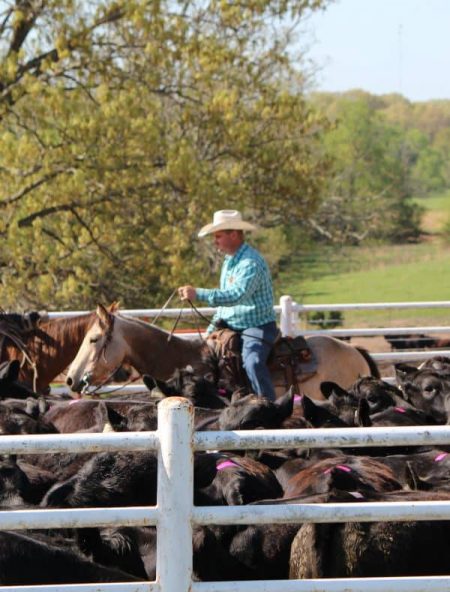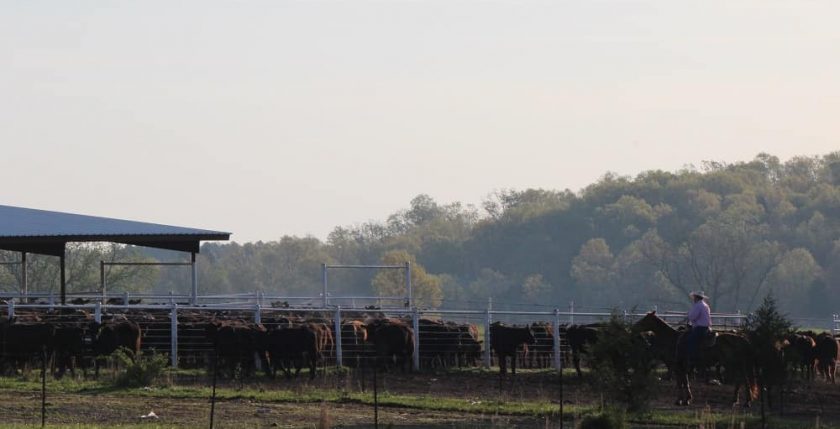Artificial Insemination (A.I.) is an investment in the future of your beef cattle herd. The ability to use semen from a genetically superior sire, synchronize your females and have more calves born earlier in the breeding season while adding uniformity to your calf crop all add up to additional dollars in your pocket. But, how can you make sure you are maximizing the return on your investment? In most cases, the success of your A.I. project comes down to three things: protocols, people and facilities.
Protocols
First and foremost, having the protocols in place to not only synchronize the females in your herd, but to ensure the females you do synchronize are good candidates for A.I., will help you achieve the results you desire.
There are a few basic rules of thumb used to ensure females are good candidates for A.I.
Criteria for synchronizing heifers:
〉 Should have achieved 60-65% of mature body weight
〉 Minimum of 50% should have a reproductive tract score of ≥ 4 at six weeks before breeding
If you don’t have a veterinarian in your area that offers reproductive tract scoring, don’t panic! You can achieve the same thing by visually observing heifers for heat in the weeks and months leading up to breeding. You want to observe at least 50% are cycling six weeks prior to breeding.
Criteria for synchronizing cows:
〉 Body condition score of ≥ 5 at calving
〉 Group should average a postpartum interval of ≥ 40 days at the beginning of the protocol
〉 Each cow should be a minimum of 21 days postpartum at the time of Eazi-Breed™ CIDR® insertion
〉 Low incidence of calving difficulty
The next thing you need to consider is what synchronization protocol will you use. Research suggests some protocols perform better than others, but just because research says it’s the best protocol, doesn’t necessarily make it the best protocol for your operation. Ask yourself three questions before choosing a synchronization protocol:
〉 How many times am I willing to put the female through the chute?
〉 How much am I willing to spend on synchronization drugs?
〉 What are my expectations for results?
Once you know the answers to these questions you can objectively analyze which synchronization program is the best fit for your operation. No matter what the research or experts tell you, the best protocol for your operation is one that aligns with your goals. It’s the protocol you are 100% confident you can perform perfectly from start to finish.
People
Hand in hand with having the proper protocols in place is having people in place to ensure the protocols are carried out correctly. Synchronization protocol compliance means the right cow gets the right shot (or CIDR insertion/removal, MGA, etc.) on the right day or at the right hour. Following the chosen protocol also means utilizing proper dosage and handling of the synchronization drugs. Here, education is key. If your whole crew understands why each step of the program is important and why timing is crucial to its success, then there will be more buy-in and everyone will take ownership of the program.

Proper cattle handling is also an important part of a successful A.I. project. Most synchronization protocols require 3-4 trips through the chute. When it comes to gathering, sorting and getting cattle through the A.I. barn, nothing is worse than having people there who don’t believe in what you are doing. Additionally, an A.I. project is no place for a hot shot, instead choose a flag whip or sorting stick.
Small changes in how you handle cattle can lead to big differences in the stress level of both the cows and your cowboy crew. If your cowboy crew is excited about A.I. day, they are calmer, more patient and easier on cattle. Less people with more experience and patience will yield better results almost every time.
Facilities
The final piece of the puzzle when it comes to a successful A.I. project is facilities. As I already mentioned synchronization protocols can require several trips through the chute, so good facilities are important, but there is no need to recreate your entire corral system or panic if you don’t think yours measures up.
If you have questions about your facility design, visit with your local A.I. professional. Most have several years of experience under their belts and have seen successful A.I. projects happen with many different set-ups. Your technician may suggest minor changes to your facilities to help handle the females in a safe, low stress and efficient manner. Many will be able to provide you with a portable breeding barn on A.I. day to make things go even more smoothly; this means if you have some pens to hold the females and sort into (if needed) and an alleyway, then you are in business.
Don’t let a lack of facilities hold you back from a project either. Again, visit with your technician. There are several options for portable corral and chute systems that can make your dream of synchronizing and breeding females on pasture a reality. Some technicians even have those set-ups available for you to use during your project.
Having the proper protocols, people and facilities in place will help you realize the maximum return on your investment in your next A.I. project. Don’t let it overwhelm you though. Put in place protocols that work best for your operation, surround yourself with people that support the project and consider small facility redesigns that can help make things flow smoothly. Most of all, if you have any questions, make sure to reach out to your local A.I. professional. They have lots of experience to draw on and are committed to your success.

